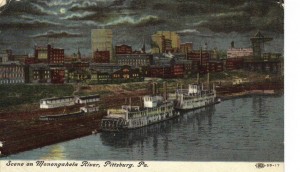Reading the Sep 2011 volume of the S&D Reflector made me think about the wide-ranging relationships of the early steamboat men. The names of the steamboat men and their vessels are interwoven on the tapestry of river history. In the Sep 2011 article “Str. PENNSYLVANIA at Wheeling“, John Panhorst , Jr. described the role his second great grandfather, Capt John Simpson Klinefelter, played in the Wheeling Bridge Case. The str Pennsylvania which Capt John Simpson Klinefelter commanded was built in Shousetown, PA in 1854.
Capt JS Klinefelter was also the master of the str Hibernia No 2. It too was built in Shousetown in 1847. After Capt JS Klineflelter’s brother, Jesse, died of cholera in 1849, Capt CW Batchelor acquired an interest in the str Hibernia No 2 and remained its master till 1852. It was during the command of Capt CW Batchelor that the str Hibernia No 2 was damaged while steaming under the Wheeling bridge.
According to the grandson of Capt Thomas S Calhoon (Dr John Ewing), Capt George Washington Ebert had an interest, either ownership in or command of, the str Hibernia* (his notation for str Hibernia No 2). Capt George Washington Ebert was my second great grandfather. I can not confirm his interest with a citation from Capt Way; nor do I know the years of his interest. What I can show, in a circular way, are the relationships of some of these captains and pilots from Beaver County, PA area which in turn suggest the Ebert interest in the str Hibernia No 2 was true.
According to Capt Way, Capt Jacob Jay Vandergrift’s first river job was cabin boy aboard the str Bridgewater when it was commanded by Capt George Washington Ebert. [1] The str Bridgewater was built in 1842/43. Later, Capt JJ Vandergrift was the master of the str John B Gordon No 2 with Capt Benjamin Mackall Laughlin serving as his clerk. Capt Jacob Poe was the principle owner of both the str John B Gordon and str John B Gordon No 2. Capt George Washington Ebert was married to Capt Jacob Poe’s sister with whom he shared ownership in many Poe family boats. Capt Benjamin Mackall Laughlin also hailed from Georgetown, PA. That evidence establishes the business relationship between Vandergrift and the Georgetown men: Ebert, Laughlin, and Poe.
Between 1845-1848, Capt JJ Vandergrift was the first mate on the str Prairie Bird owned by his uncle Capt John Vandergrift. CW Batchelor and William J Kountz of Civil War fame, were pilots on the str Prairie Bird. CW Batchelor married the daughter of John Vandergrift. That seals the family relationship of Vandergrift and Batchelor.
In 1859 Capt JJ Vandergrift built the str Conestoga which served in the Civil War until it was damaged in a collision with the str Gen Price on 8 Mar 1864 near Grand Gulf, MS. All of these named men served during the Civil War in the western theater – another link in the chain connecting their names. Like Capt Thomas S Calhoon, Thomas W Poe, and Jacob Poe, JJ Vandergrift lost a vessel, the str Red Fox, while towing coal barges to Island No 10. Like the other owners, he also received no indemnity from thet US government before 1895. [2]
In 1874, Capt Frank Y Batchelor, the brother of Capt CW Batchelor, acquired the str Mollie Ebert from Capt George Washington Ebert. The str CW Batchelor named to honor Capt CW Batchelor, was the Saturday boat in the Pittsburgh and Cincinnati Packet Line in 1892 -93. The Pittsburgh and Cincinnati Packet Line was organized by Georgetown men: Capt Thomas S Calhoon and Capt Jackman Taylor Stockdale. Theodore C Poe, son of Capt Jacob Poe, was the clerk of the str CW Batchelor. That bonds the business relationships between Batchelor and the Georgetown men: of Ebert, Calhoon, and Stockdale.
I recognize this analysis is a classic example of loopy logic. But is also illustrates the rich and long-standing relationships of these steamboat men who competed for river business and yet worked together often on nothing more than a shake of hands.
As a key to this example, I intentionally focused on JJ Vandergrift because other than Henry M Shreve, Jacob Jay Vandergrift is the only steamboat cabin boy, mate, pilot, or captain to be recognized on a PA Historical Marker. Even with his long career as a steamboat man, the marker only commemorates his work as a pioneer in the transportation of petroleum and natural gas from the PA oil country in the 1870′s. At that time it was reported that Jacob Jay Vandergrift was one of the wealthiest men in the world.
References.
[1] Contemporary American Biography Biographical Sketches of Representative Men of the Day, (Atlantic Publishing and Engraving Co, New York, 1895), p 46.
[2] Contemporary American Biography Biographical Sketches of Representative Men of the Day, (Atlantic Publishing and Engraving Co, New York, 1895),p 48.
![Kenton steam11729r[2] (2) Str Kenton Bill of Sale dated 23 Oct 1861 (From the Collection of the UW La Crosse Murphy Libraray Special Collections)](http://georgetownsteamboats.com/gs/wp-content/uploads/2009/07/Kenton-steam11729r2-2.jpg)
